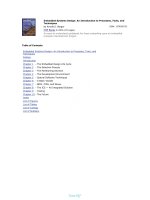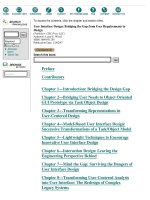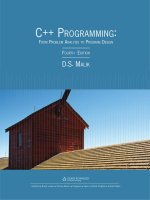Force character design from life drawing (gnv64)
Bạn đang xem bản rút gọn của tài liệu. Xem và tải ngay bản đầy đủ của tài liệu tại đây (26.11 MB, 255 trang )
This page intentionally left blank
Force
Character Design
from Life Drawing
By Michael D. Mattesi
Visit me at:
Drawingforce.com
Enterartacad.com
AMSTERDAM • BOSTON • HEIDELBERG • LONDON
NEW YORK • OXFORD • PARIS • SAN DIEGO
SAN FRANCISCO • SINGAPORE • SYDNEY • TOKYO
Focal Press is an imprint of Elsevier
Acquisitions Editor: Georgia Kennedy
Publishing Services Manager: George Morrison
Project Manager: Paul Gottehrer
Cover Designer: Alisa Andreola
Focal Press is an imprint of Elsevier
30 Corporate Drive, Suite 400, Burlington, MA 01803, USA
Linacre House, Jordan Hill, Oxford OX2 8DP, UK
Copyright © 2008, Elsevier Inc. All rights reserved.
No part of this publication may be reproduced, stored in a retrieval system, or transmitted
in any form or by any means, electronic, mechanical, photocopying, recording, or otherwise,
without the prior written permission of the publisher.
Permissions may be sought directly from Elsevier’s Science & Technology Rights
Department in Oxford, UK: phone: (ϩ44) 1865 843830, fax: (ϩ44) 1865 853333,
E-mail: You may also complete your request on-line via the
Elsevier homepage (), by selecting “Support & Contact” then
“Copyright and Permission” and then “Obtaining Permissions.”
Library of Congress Cataloging-in-Publication Data
Application submitted
British Library Cataloguing-in-Publication Data
A catalogue record for this book is available from the British Library.
ISBN: 978-0-240-80993-9
For information on all Focal Press publications
visit our website at www.books.elsevier.com
08 09 10 11 12
Printed in China
5 4 3 2 1
This book is dedicated to all of my students.
Thank you for allowing me to inspire you and watch you grow.
I am so proud of you!
Special Thanks
I want to thank the many people that made this book happen. First off to Paul Temme
for finding my first book, Force: the Key to Capturing Life Through Drawing and bringing it over to Focal Press. If that had not happened then this book would not exist. To
Georgia Kennedy, my editor at Focal, thank you for your trust in my ideas, nothing is
more priceless! Thank you to all of the models who work hard to inspire us artists!
Speaking of artists, a special thanks to the contributing friends/professionals that took
their own time to share with us their insight on character design! Always a thank you to
my family for helping me not feel so guilty for the time I lose with you as I work on my
books! I love you.
Mike/Daddy
Contents
Foreword
Preface
Key Concepts
Fear
Risk
Opinion
Hierarchy
Contrast and Affinity
ix
xi
xiii
xiii
xiii
xiii
xiv
xiv
Chapter 1: Force with Character
Amazing Angles
Developing Ideas
1
15
22
Chapter 2: Space with Character
Forceful Form
The Spatial Bounding Box—Size Equals Depth
Location Equals Depth
37
37
43
54
Chapter 3: Shape with Character
Abstraction of Shapes
Forceful Shape
The Forceful Triangle
The Brilliant Bounding Box Returns
The Law of Thirds
Facial Ratios
61
62
64
69
74
81
88
Chapter 4: Costume with Character
Tone or Value
Color Theory
Character Inspiration
Imaginative Design
95
96
99
150
154
Chapter 5: Reportage with Character
Finding Character
Character Layout
Architecture with Character
171
172
188
196
Chapter 6: Animals with Character
207
Closing
229
Artist Bios
231
Index
237
This page intentionally left blank
Foreword
The main thing about character design is that the character, whether good or evil,
MUST have appeal and tell a story. Look at pirate drawings by Marc Davis. They have
a wonderful appeal and charm even though they are tough guys. The ability to do
drawings that have a touch of humor and personality in them is key and something we
all strive for. Even if you do a character that is a cliché, you never want to draw an
illustrated cliché. You want to keep it fresh and appealing and full of character.
Simply put, if I were going to design a fat man I would study Jackie Gleason and
observe how he carries himself, his mannerism, and his way of posing and moving. If
I were to design a skinny guy I would study Stan Laurel or Dick Van Dyke and how
they carry themselves and how they move. Then I’d study the differences and incorporate the personality traits and back story that are signature to that character. That is
character design.
My cartooning heroes were the great sport cartoonist Willard Mullin, British cartoonist
by way of New Zealand for the Evening Standard of London, David Low, who
Winston Churchill said was worth two battleships during WWII, that’s how good
he was.
Character design is always about the story as much as the drawing.
Rik Maki
This page intentionally left blank
Preface
The book you hold in your hands is a first of its kind. There are figure drawing books
and there are character design books but there is no book that explains the bridge
between the two. From my own work experience, this I have found is one very important bridge, a bridge of inspiration!
In high school, I remember refusing to look up reference for the comic books and other
art projects I was working on. I thought that was uncreative and cheating. I could not
have been further from the truth. In my own professional history, now spanning sixteen
years through film, television, and video games, I know that when I am cornered with
the lack of an idea or my own repetitive thoughts, I look up reference! The more I know
about my subject, the more sophisticated my ideas become.
As I get acquainted with an ever growing pool of professionals in the entertainment
industries, I consistently see that the best of them use reference all of the time. This
grows the “internal encyclopedia.” Without all of this research, your well is very shallow or almost dry. So, with this theory in mind, I will show you in the pages of this
book how we can experiment and explore creativity through experiencing the encyclopedia of the figure!
In drawing from a model, you are given a tremendous amount of information to be
inspired by. The vast variety of forces, forms, shapes, textures, and colors can keep
you intrigued for a lifetime!
Many schools do not instruct their students on how to enjoy drawing from the model or
that they have the power and control to make creative choices from the model. In running Entertainment Art Academy, I saw students come from other schools of thought
where measuring and pure technical prowess were the forefront to drawing. These students came to me in hopes of enjoying the act of drawing again. There is no right or
wrong to figure drawing. You MUST find a way that is enjoyable to you. The drawings
you see in my books are MY way of enjoying myself while drawing. Since I am selfanalytical, I can teach what I do when I play. Believe it or not, there is method to my
madness. These methods and desires are what I share with you.
My first book, Force: Dynamic Figure Drawing for Animators, discussed how to understand and experience the organic, rhythmic energy of humanity and translate it in your art.
I discussed how the foundation to all creation is honesty. First one must be able to capture
basic truth. What do I mean by that? Well, I mean a pure, lucid UNDERSTANDING of
xii
Preface
the particular model at a particular time. There is as little opinion as possible. There is only
an appreciation and understanding of what you are experiencing in front of you. One of
the hardest things to do is be visually honest. Once you understand, you can’t help but
admire the magnificence of the humanity in front of you.
This book deals with forcing your drawings to become what YOU want them to
become. What are your OPINIONS about the subject? How will you tackle realizing
YOUR IDEAS?
An invasion of armies could be resisted, but not an idea whose time has come.
Victor Hugo
Opinion of the story in front of you can lead to a clearer truth of the model. In admiring
the model, you open yourself up to being more sensitive to what is in front of you. This
sensitivity creates opinion.
Learning to draw the figure with opinion leads to many jobs out in the world of entertainment art. The best character designers, storyboard artists, and visual development
artists use life as their reference point.
Character is what drives great intellectual properties. Think back to the films or cartoons that really made an impression on you. Characters, not plots, drove them. The
clearer the character the more the audience, us, gets connected to the story. Know
WHO the character is and why the character is that way. How does this character act
in different situations? In Burbank, home of the world’s top animation studios, one test
for a good character is to put it in a box and know how the character would react to
the situation. Would it get scared, frustrated, happy, angry, or curious …? The choices
are limitless. A great character is so clear in your mind that you know how it would act
in ANY situation. Mickey Mouse, Bugs Bunny, or Snoopy are all clearly defined. They
would all act differently in the box.
The character designer’s job is to create the character’s morals and thoughts visually on
the page. Is this character funny, naïve, serious, aggressive, dumb, etc.? Know its role;
know if the visual representation of the character presents it well.
On the following pages you will find drawings that represent my ideas and the fun
experiences I had creating them along with many professional artists’ experiences.
Key Concepts
There are some basic key concepts to help you with your journey. Let’s go through them
together.
FEAR
Here I am again writing about fear. I have been teaching an additional six years since
the first printing of Force and I can honestly say again, that fear is the biggest detriment
to the forward pursuit of education. Fear comes in all forms, some more obvious than
others. The fastest way out is to listen to your internal dialogue. Notice when and why
you are indecisive or concerned. Let drawing be about your experience and curiosity,
not final product. You create the fear so rid yourself of it! It will only slow you down.
RISK
Well, we just spoke about fear and here we are talking about risk. Doesn’t that cause
fear? Yes, good fear. What can happen to you if you take a risk and you don’t get the
results you want? In order to have opinion, you MUST be able to take risk! You
MUST fight your fears. You MUST be willing to fall on your face to pursue your creativity! Once you break the bonds of fear, and love feeling risk while you work, you
will never turn back. Besides, we are not sky diving, we are drawing. Nothing can
harm you!
OPINION
Strengthening your ability to take greater and greater risks allows you to get out of the
“kind of” factor. New students look at life and “kind of” see it. You must see truth in
order to form opinion. Opinions come from heightened clarity! Don’t draw with mediocrity, stride for opinion through clarity. What are you trying to say? In my first book, I
discuss writing your purpose on the drawing page itself. The purpose in the other book
was a concept based on force. In this book, we can bring that concept to creative
ideas. You might have a thought that is an analogy. Perhaps the model’s pose reminds
you of an animal, natural power, architecture, culture, a time period, a character, automobile or other famous artists’ work. Draw upon your intuition to inspire your
experience.
xiv
Key Concepts
HIERARCHY
Thinking hierarchically, or from big to small, is a profound method to assessing challenges. Hierarchy creates a clearly defined path that then assists in the comprehension
of complex ideas. It seems human nature to initially resist this idea. We want to get
mired in the details instead of seeing the big picture. Hierarchy is so profound that you
can use it on anything, not just your drawing experience. It could be used to organize
your process for food shopping, the flow of automotive traffic, personal relationships,
and more.
In drawing the figure, whole pyramid represents the main idea of the pose. Then within
it, the top of the pyramid is the biggest idea, and they get smaller as we travel down
the levels of the pyramid. So, a pose is the whole pyramid, the top is the hip to ribcage relationship, the next tier is arms, legs, and head, and then the last is hands, feet,
fingers, and toes. As one gets more sophisticated, the top of the pyramid might be the
face and right hand because they best represent the main idea or story of a pose.
CONTRAST AND AFFINITY
While working at Walt Disney Feature Animation, one of the best rules I learned was
“CONTRAST CREATES INTEREST.” Never forget that. Beware mediocrity through the
lack of contrast. Look for idiosyncrasies. Watch out for symmetry, parallel moments, and
monotonous line. This rule works for character design, landscape painting, film editing,
writing, and all works artistic. Contrast is self-explanatory but how many ideas can be
contrasted? That is where the magic happens. A line on a piece of paper can have
much contrast or little contrast. Is the line parallel to the edges of the paper or is it at a
Key Concepts
forty-five degree angle? Is there variety in the weight of the line? How long or short is
the line? Does it go off of the page? All of these possibilities represent different ideas in
the world of art. Remember that every mark on the page has meaning, a meaning to
create the bigger purpose of the artist’s statement!
Affinity or unity means pick what repeats in the drawings. Now, with the nude figure,
there is the obvious, such as two hands or two feet. In creating character designs and
especially clothed ones there can be patterns in shape, color, tone, line, and much more.
Design is an abstract way of looking at our world and using it to communicate our
thoughts. Your art is only as powerful as your thoughts and how you communicate them
with your skills. I hope to present you with some new tools to assist you in communicating your experiences. Enjoy the journey!
xv
This page intentionally left blank
Chapter 1
Force with Character
In this first chapter, we are going to experience the risk of pushing our drawings to their
forceful extremes. Why? Because pushing poses helps you define character. How far
can a drawing go before it falls apart? In what direction do I push the pose? Let’s
investigate these and other questions in our search for answers.
The golden rule I abide by in designing from life is that the drawing must work or
function the way my subject did. So, if it is a figure, it has to follow my rules from the
first book. Rhythm must continue through the figure in discussion. Does my understanding of the figure’s rhythms come through all of my other opinions?
So, as a Force refresher, the arrows in the following diagrams represent the lines you
draw with. Each line is a force. In my book Force: Dynamic Life Drawing for Animators,
I discuss in great detail how force works and the pitfalls that artists fall into that disrupt
force in their experience. These diagrams show how the abstraction of force operates
and how we can manipulate it.
The image on the left shows a weak amount of applied force, the orange arrow,
pushing upon the dark blue directional force. If we take the same directional force
and apply more force to it as shown in the right diagram, see how much more
curved it becomes.
2
Force: Character Design from Life Drawing
The rhythm on the left side of the page is weaker simply because the angle of applied
force, represented here by the orange arrow, is weaker. On the right, we can see an
illustration of a more dramatic rhythm because the applied forces are on much stronger,
forty-five degree angles. I am going to walk you through this chapter starting with
more subtle drawings of opinion to clear and loud exaggerations.
Force with Character
This drawing presents subtle opinion. The arm’s leftward stretch is in opposition to
that of the lower belly. My experience here is clearly spoken without any real
exaggeration. It states my intent without screaming. Notice the line weight in the
lower abdomen. I added more pressure to my marks because of my thinking about
the forces and gravity found there.
3
4
Force: Character Design from Life Drawing
Force is starting to get extreme. The upward thrust in the hip is the obvious main
focus. Knowing this is what allows me to push that main idea. Without that thought,
I cannot push an opinion. The strength of that curve is what makes it feel so extreme.
Force with Character
The pulling inward with the hands and curving of the back help the body in one clear
purpose. The trick here is to be aware of the relationship of these forces. The arms
are brackets of force from the back to the shoulders, down to the elbows, and into
the hands. The unobvious lies in being sensitive to this experience. I had to allow the
drama and energy of this pose to affect me for the drawing to have this impact. If I
disconnect myself from it and maybe confronted the experience through the act of
measuring, I would have lost this feeling in the drawing. It is his effort that I wanted
to empathize with.
5
6
Force: Character Design from Life Drawing
Rhythm is of primary concern to this experience. Force number one moves down to
the hips and splits off into the legs. I used the orange arrows here to represent
applied force and how it connects forces. The thrust in the upper body, linked into the
arms and hands, must work here in conjunction with the hips and legs. I love the
gnarled right hand. My immediate impression came across in the drawing. This
drawing was achieved with a Lyra 9B lead crayon.
Force with Character
Weight was the main idea here. With this in mind and as my main story point, I
pushed that thought into the belly, the hanging of the arms, the drop of the legs, and
the pull on the feet. The forward charge of the head also assists in this sensation.
7
8
Force: Character Design from Life Drawing
Here the main idea of the story is the lunge in the right shoulder. You can see my
effort placed into this moment in the pose. From there, force slides its way down to
the feet and down through the right arm.
Force with Character
This one-minute drawing shows how powerful the simplicity of force is. The curves of
force in the upper body, legs, and arms relate to one another to keep the figure
connected.
9









